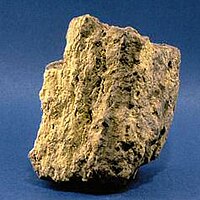
Photo from wikipedia
Brittle faults and fault zones are important fluid flow conduits through the upper part of Earth’s crust that are involved in many well-known phenomena (e.g. earthquakes, thermal water and gas transport, or… Click to show full abstract
Brittle faults and fault zones are important fluid flow conduits through the upper part of Earth’s crust that are involved in many well-known phenomena (e.g. earthquakes, thermal water and gas transport, or water leakage to underground tunnels). The permeability property, or the ability of porous materials to conduct water and gas, is one of the key parameters required in understanding and predicting fluid flow. Although close to a thousand studies have been done, and permeability tested in parts of fault zones, a sytematic summary and database is lacking. This data descriptor is for a multi-disciplinary world-wide compilation and review of bulk and matrix permeability of fault zones: 410 datasets, 521 reviewed sites, 379 locations, >10000 publications searched. The review covers studies of faulting processes, geothermal engineering, radioactive waste repositories, groundwater resources, petroleum reservoirs, and underground engineering projects. The objectives are to stimulate the cross-disciplinary data sharing and communication about fault zone hydrogeology, document the biases and strategies for testing of fault zones, and provide the basic statistics of permeability values for models that require these parameters. Measurement(s) permeability Technology Type(s) digital curation Factor Type(s) data source • geographic location Sample Characteristic - Environment geological fault Machine-accessible metadata file describing the reported data: https://doi.org/10.6084/m9.figshare.11933391
Journal Title: Scientific Data
Year Published: 2020
Link to full text (if available)
Share on Social Media: Sign Up to like & get
recommendations!